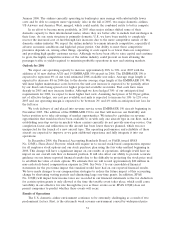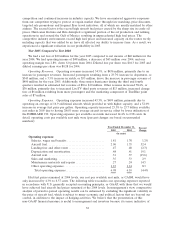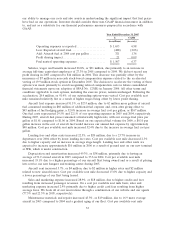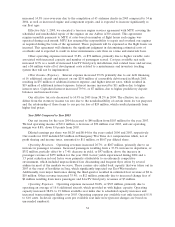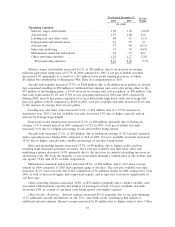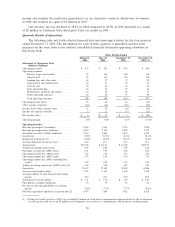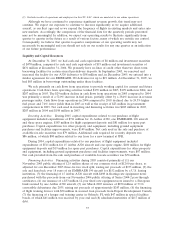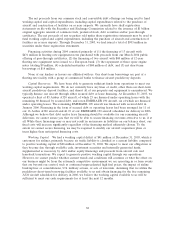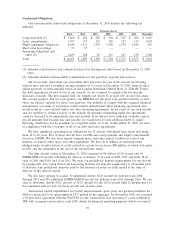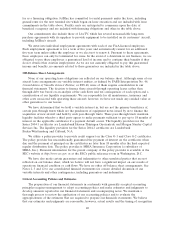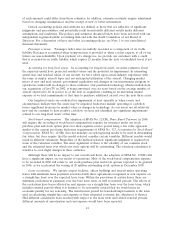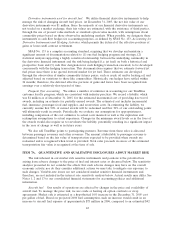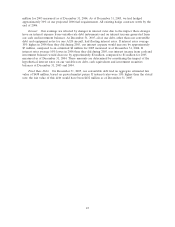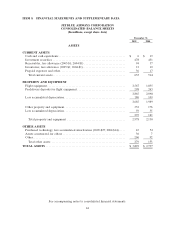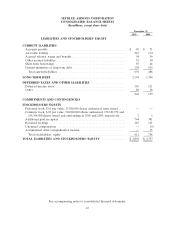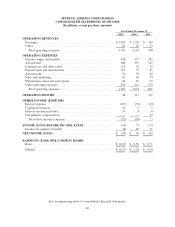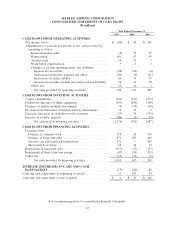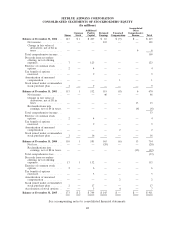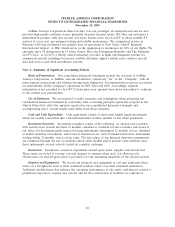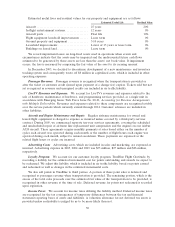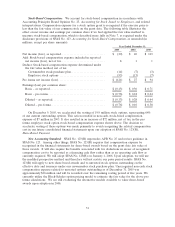JetBlue Airlines 2005 Annual Report Download - page 49
Download and view the complete annual report
Please find page 49 of the 2005 JetBlue Airlines annual report below. You can navigate through the pages in the report by either clicking on the pages listed below, or by using the keyword search tool below to find specific information within the annual report.of such amounts could differ from those estimates. In addition, estimates routinely require adjustment
based on changing circumstances and the receipt of new or better information.
Critical accounting policies and estimates are defined as those that are reflective of significant
judgments and uncertainties, and potentially result in materially different results under different
assumptions and conditions. The policies and estimates discussed below have been reviewed with our
independent registered public accounting firm and with the Audit Committee of our Board of
Directors. For a discussion of these and other accounting policies, see Note 1 to our consolidated
financial statements.
Passenger revenue. Passenger ticket sales are initially recorded as a component of air traffic
liability. Revenue is recognized when transportation is provided or when a ticket expires, as all of our
tickets are non-refundable. Upon payment of a change fee, we provide our customers with a credit
that is recorded in air traffic liability, which expires 12 months from the date of scheduled travel if not
used.
Accounting for long-lived assets. In accounting for long-lived assets, we make estimates about
the expected useful lives, projected residual values and the potential for impairment. In estimating
useful lives and residual values of our aircraft, we have relied upon actual industry experience with
the same or similar aircraft types and our anticipated utilization of the aircraft. Changing market
prices of new and used aircraft, government regulations and changes in our maintenance program or
operations could result in changes to these estimates. Our purchased technology, which resulted from
our acquisition of LiveTV in 2002, is being amortized over six years based on the average number of
aircraft expected to be in service as of the date of acquisition, resulting in an increasing annual
expense as we had commitments at that time to purchase additional aircraft over the next three years.
Our long-lived assets are evaluated for impairment at least annually or when events and
circumstances indicate that the assets may be impaired. Indicators include operating or cash flow
losses, significant decreases in market value or changes in technology. As our assets are all relatively
new and we continue to have positive cash flow, we have not identified any significant impairments
related to our long-lived assets at this time.
Stock-based compensation. The adoption of SFAS No. 123(R), Share Based Payment, in 2006
will require the recording of stock-based compensation expense for issuances under our stock
purchase plan and stock option plan over their requisite service period using a fair value approach
similar to the current pro forma disclosure requirements of SFAS No. 123, Accounting for Stock-Based
Compensation. SFAS No. 123(R) does not mandate an option-pricing model to be used in determining
fair value, but does require that the model selected consider certain variables. Different models would
result in different valuations. Regardless of the method selected, significant judgment is required for
some of the valuation variables. The most significant of these is the volatility of our common stock
and the estimated term over which our stock options will be outstanding. The valuation calculation is
sensitive to even slight changes in these estimates.
Although there will be no impact to our overall cash flows, the adoption of SFAS No. 123(R) will
have a significant impact on our results of operations. Most of the stock-based compensation expense
to be recorded in 2006 will relate to our stock purchase plan and stock options expected to be granted
in 2006, as we accelerated the vesting of 20 million outstanding stock options in December 2005.
Lease accounting. We operate airport facilities, offices buildings and aircraft under operating
leases with minimum lease payments associated with these agreements recognized as rent expense on
a straight-line basis over the expected lease term. Within the provisions of certain leases there are
minimum escalations in payments over the base lease term, as well as renewal periods. The effects of
the escalations have been reflected in rent expense on a straight-line basis over the lease term, which
includes renewal periods when it is deemed to be reasonably assured that we would incur an
economic penalty for not renewing. The amortization period for leasehold improvements is the term
used in calculating straight-line rent expense or their estimated economic life, whichever is shorter.
Had different conclusions been reached with respect to the lease term and related renewal periods,
different amounts of amortization and rent expense would have been reported.
41


